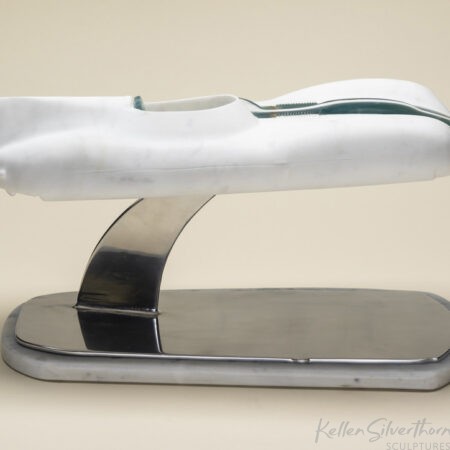B. S. C. – inspired by Jaguar D-Type
hover and click over individual sculpture photographs to enlarge
THE CAR

https://commons.wikimedia.org/wiki/File:Cunningham_C-4RK_recreation,_front_left_%28Greenwich_2018%29.jpg
Briggs Swift Cunningham Junior, did more to elevate American Road Racing colors (white with blue stripes) than anyone else in the 1950’s and early 1960s. He was an organizer and promotor, an entrant, and a driver, dealer and distributor. His number one goal was to win Le Mans with an American car and American drivers. He came up a little short, but earned the respect of everyone with his grace, perseverance, and sense of fair play.
Briggs was born in 1907 to a wealthy Cincinnati family. The family spent summers in Connecticut. His somewhat elderly father died when Briggs was age 7, and the boy came under the increasing influence of a car-mad uncle. Nevertheless, Briggs kept his promise to his mother not to race cars while she was alive.
B.S.C. helped launch post-WW II road racing in America. Together with Yale classmates Sam and Miles Collier, they formed the Auto Racing Club of America, that would later evolve into the SCCA (Sports Car Club of America).
Cunningham bought and raced many cars, including from Ferrari, Maserati, OSCA, Abarth, Siata, Corvette, Cooper, Jaguar, Healey, Lotus, MG, Aston Martin, Lister, Mercedes, and Porsche. When offered entries into the 1950 Le Mans, Briggs bought the enterprise making Fordillacs — mating 1949-50 Ford chassis to Cadillac’s overhead valve V8s. When the ACO demurred on the Fordillacs, instead Cunningham took a pair of 1950 Cadillacs chassis to Le Mans. That event made him a household name in both America and France.
He returned to Le Mans for five more years (1951-55) with cars of his own design and construction, typically powered by Chrysler Hemi V8s. These Cunningham-Chryslers did extremely well, with numerous Top 5 finishes, but came up short of Le Mans overall victory against the disc-brake equipped Jaguars and exotic V12 Ferraris.
Cunningham’s entries had even greater success at the sole US round of the Sport Car World Championships, the 12 Hours of Sebring. In particular, an outright win for the Cunningham C4-R in 1953 by drivers Phil Walters and John Fitch.
Threatened with losing the tax deductibility of racing his Cunninghams, BSC then switched to distributing and racing Jaguars, and later Maseratis. By adapting his Teams, Cunningham’s stable was able to carry on and three-peat outright victories at Sebring. In 1954 Sebring victors were Bill Lloyd and Stirling Moss in an OSCA MT4, and in 1955 again Walters, this time paired with future F1 Champion Mike Hawthorn in a Jaguar D-Type.
Corvette fans all know that in the 1960 Le Mans 24 Hour race a Cunningham Corvette finished 8th overall, and 1st in production car, with a fuel injected C1 Corvette. This was Corvette’s finest competition hour of that era. Consequently, Briggs Cunningham was inducted into the Corvette Hall of Fame in 2019.
The briggscunningham.com website lists all of the entry numbers for all of the drivers who raced with BSC. The 72-member list is a literal Who’s Who of American racing in the late 1950s. Some of the more illustrious names not already listed include: Dan Gurney, Phil Hill, Roger Penske, the Collier brothers, Luigi Chinetti, Bob Grossman, Dick Thompson, Denise McCluggage, Walt Hansgen, and Augie Pabst.
Among international stars who drove BSC’s white with blue stripe cars included: include Stirling Moss, Roy Salvadori, Mike Hawthorn, Bruce McLaren, Chris Amon, Jack Brabham, Colin Chapman, Jochen Neerpasch, Archie Scott-Brown, Ivor Bueb, and Duncan Hamilton.
BSC himself topped the number of driver entries from his stables, at 186 races from 1949-64. Walt Hansgen is next closest at 180 entries. Alfred Momo was Briggs’ dear friend and Team Manager for most races.
BSC’s other love was sailboat racing. Cunningham didn’t build quite as many racing sailboats as racing cars. He did successfully finance, and captain Columbia’s defence of the America’s Cup in 1958.
After retiring from racing at age 58 in 1965, Cunningham operated a car museum from 1966-86 in Costa Mesa, California based around his outstanding auto collection. The collection was then bought by the Collier family and moved to its current location in Naples, Florida (the Revs Institute, open to the public since 2014).
The sculpture is of a 1955 Jaguar D-Type short nose in American racing colors. 1955 is the single year with D-Types featuring monoposto style cockpit, as LeMans rule changes for 1956 required a full width windscreen.
The History of the D-Type is covered in greater detail in my Troispetition sculpture write-up, which depicts a 1956 Long nose. https://kellensilverthornsculptures.com/sculptures/troispetition/.
A further account of Briggs can be accessed online at https://www.hagerty.com/media/market-trends/hagerty-insider/the-founding-fathers-of-car-collecting-briggs-cunningham/?utm_source=SFMC&utm_medium=email&utm_content=MED_UN_NA_EML_UN_DailyDriver_Monday&hashed_email=b76431c76816f51cba756662faf9d8fe1d316a9f9af0fad2fca204e90190e547
Those seeking a more affordable alternative to a stone D-Type KSS creation, should check out the cast aluminum KSS work Roundabout Menace.
THE STONE
Carrera White marble is the benchmark of stone sculpting. It’s what Michelangelo used when sculpting his masterpiece David. It is truly a delight to work, and evokes such a sense of history for me. More so, as I created the piece not long after a trip to Paris – a delight for any sculpture devotee. Carrera White is rather homogenous white, with view faint veins and inclusions. Most sculptors take statuario to just 100-300 grit where it delivers a matt luster, with some residual pinpoint sparkles.
It is always good sculptor / design form to match a mostly homogenous stone, with inlays of an inhomogeneous stone. In this case, the inhomogeneous stone is Andes Blue Onyx from Argentina. It appears as blue and blue-green facets with some off-white and off-brown veining. High lustre results when onyx is taken above 1000 grit and oiled.








